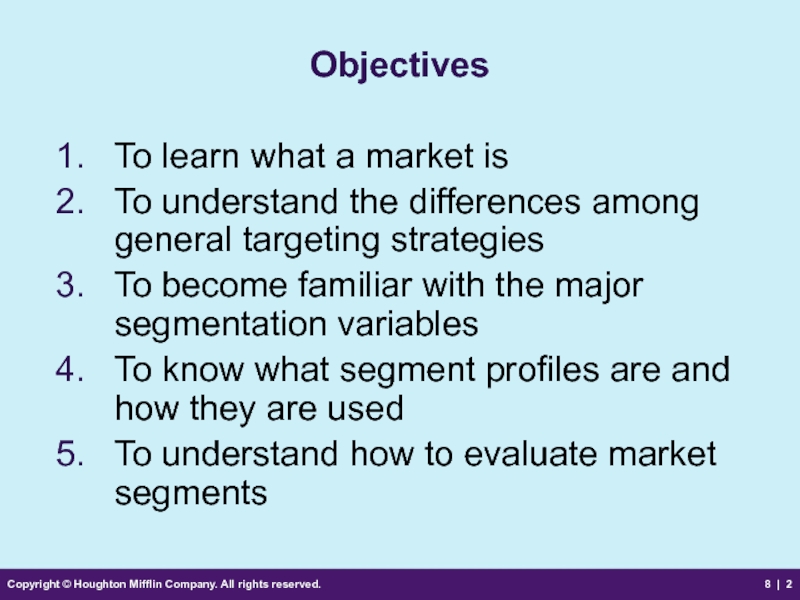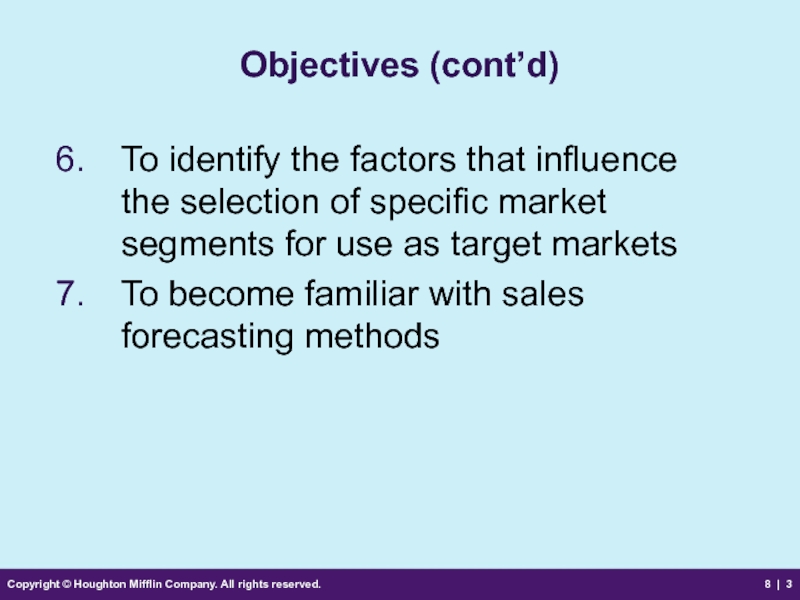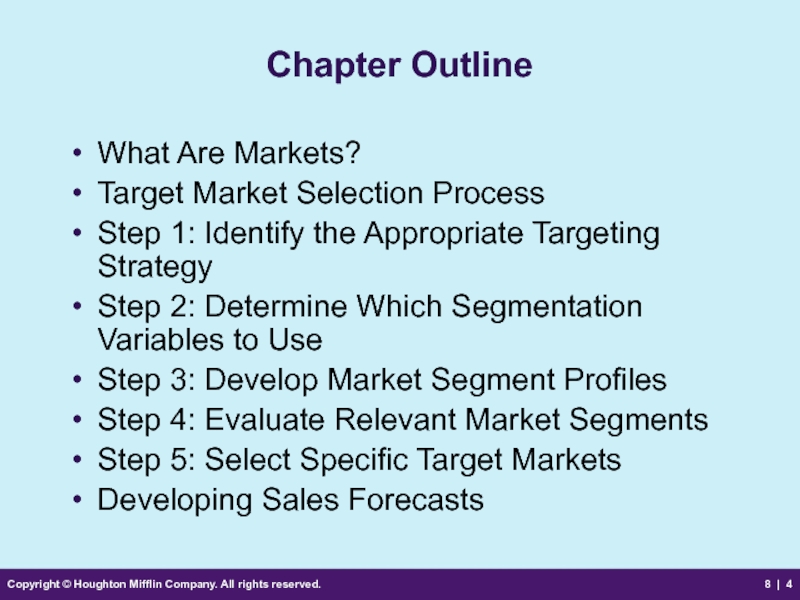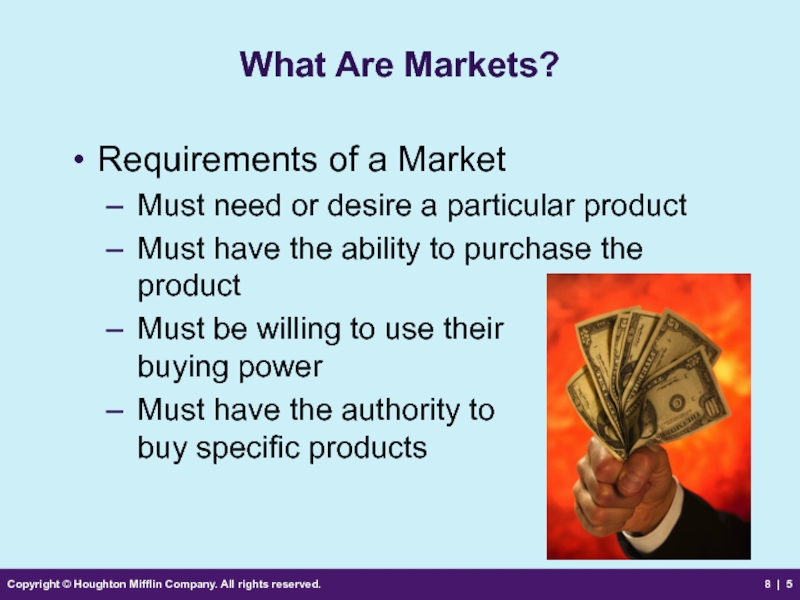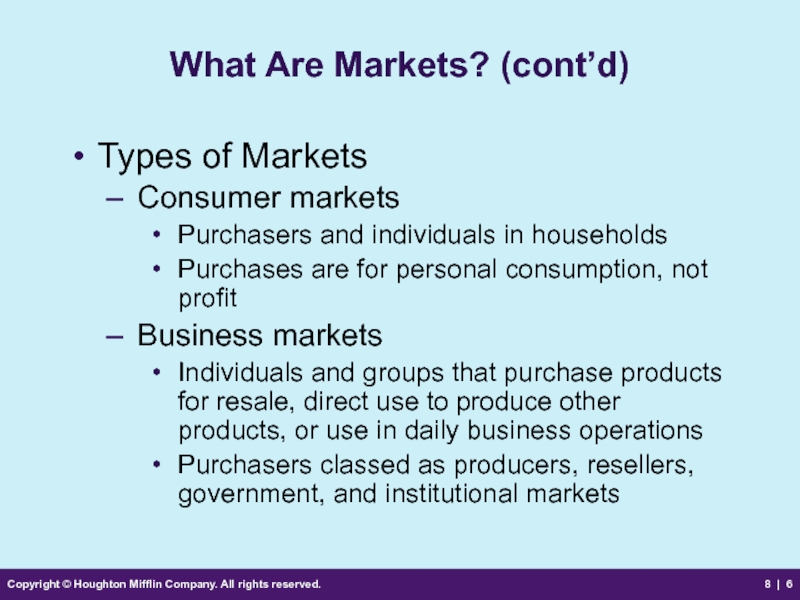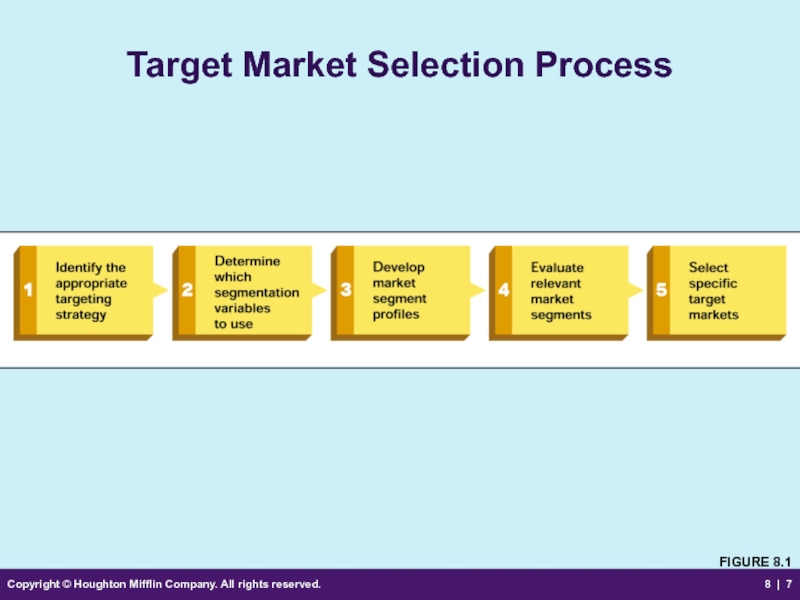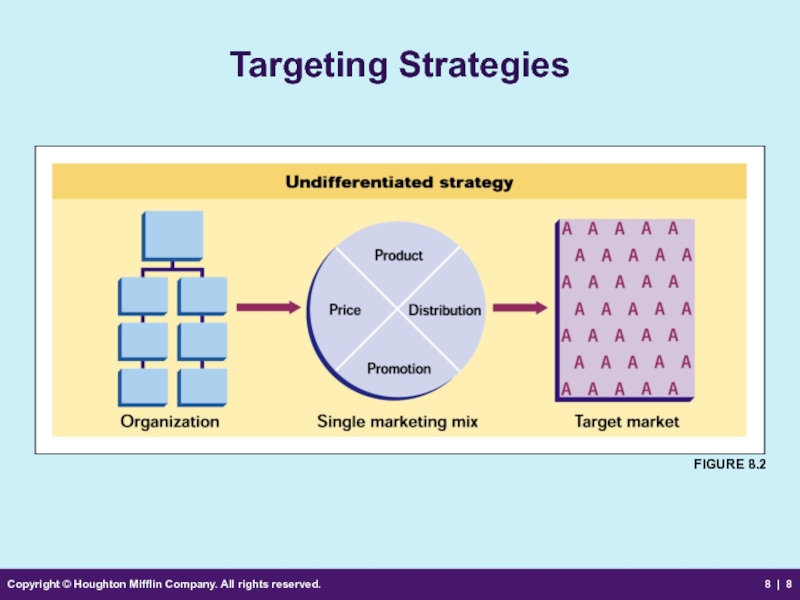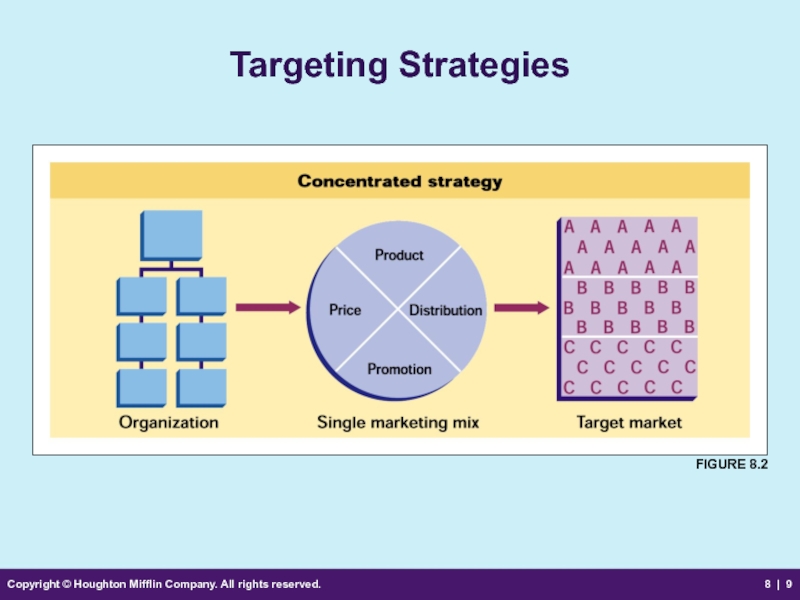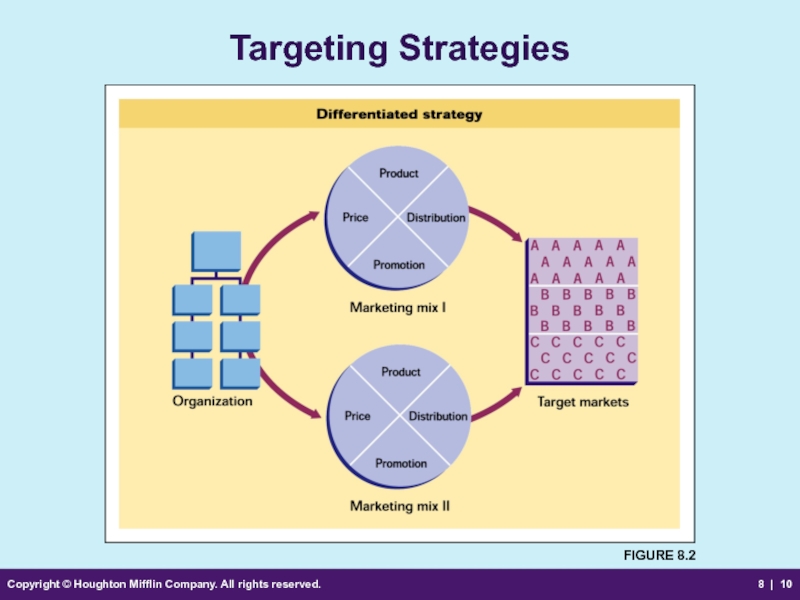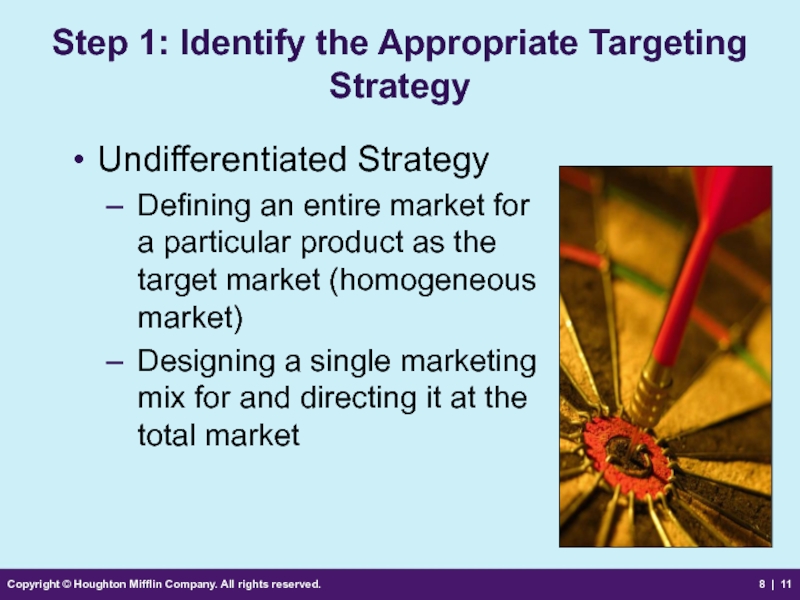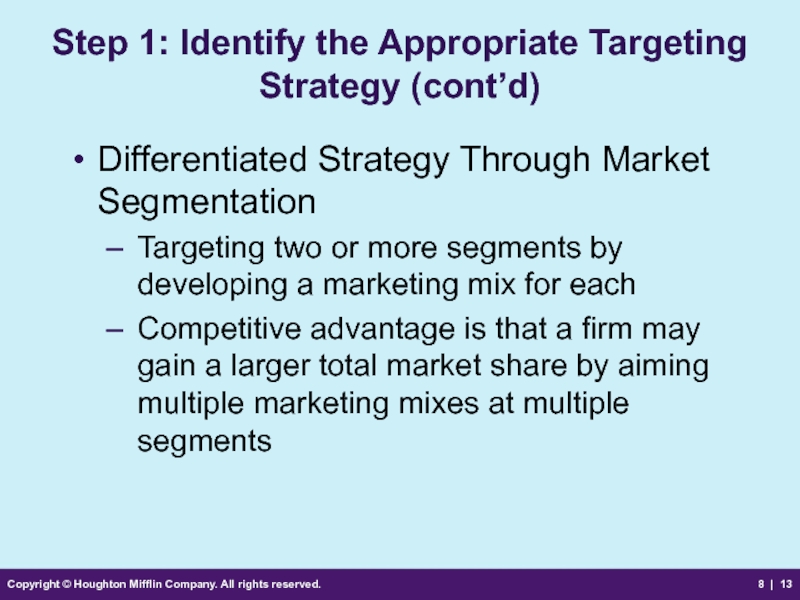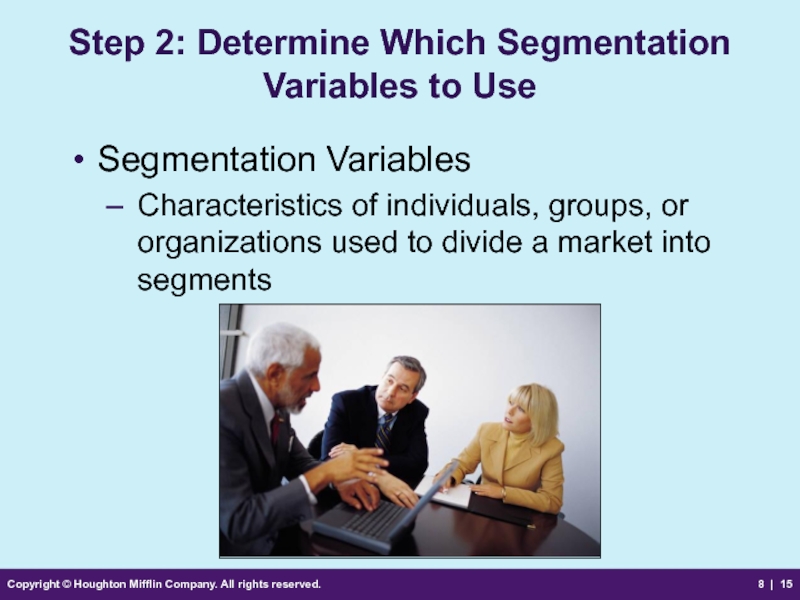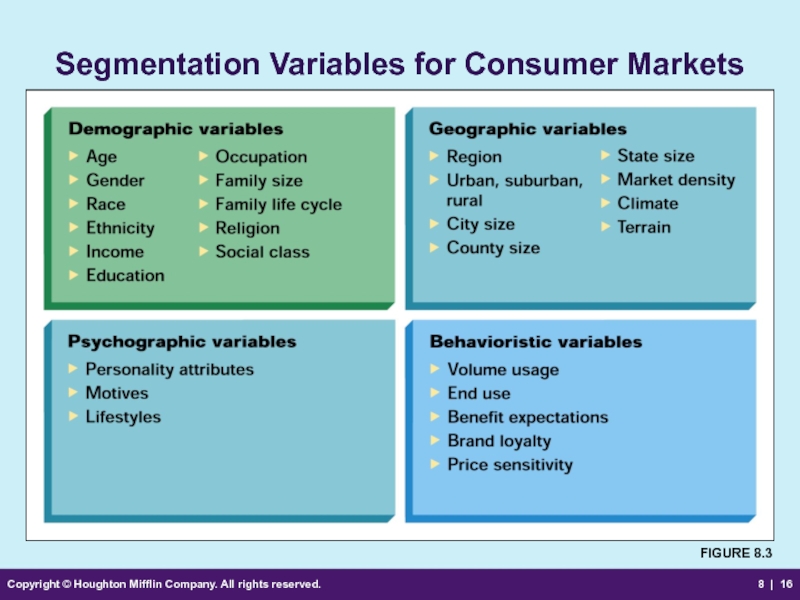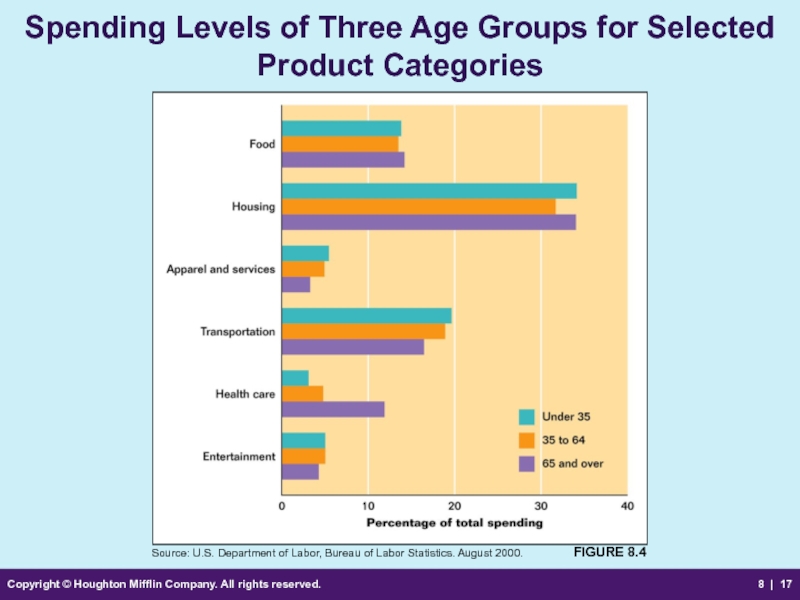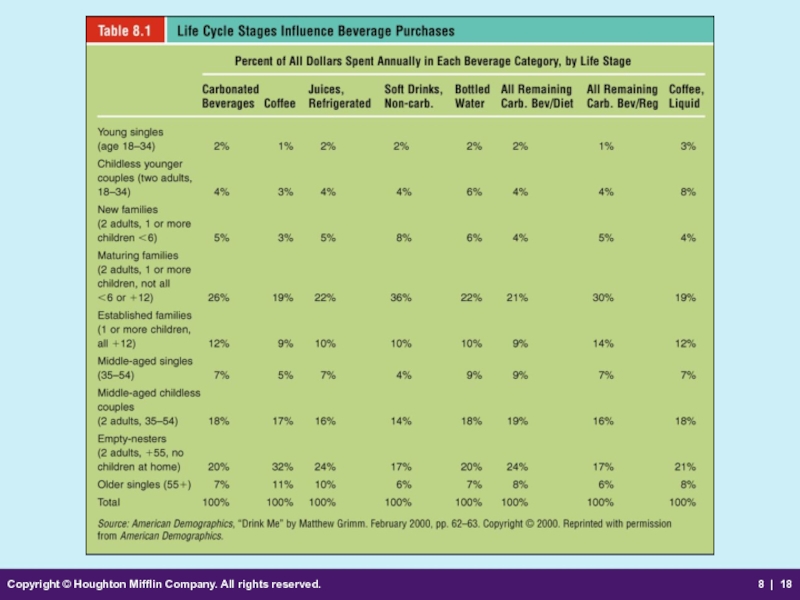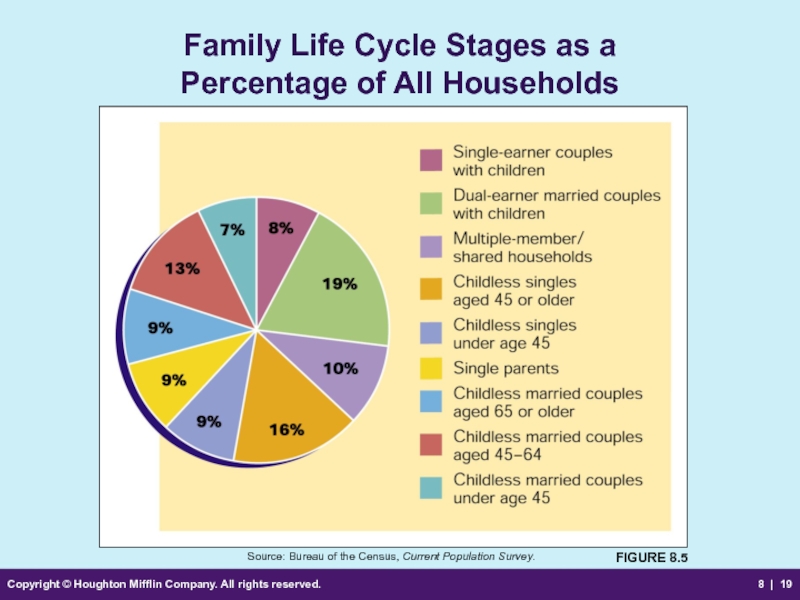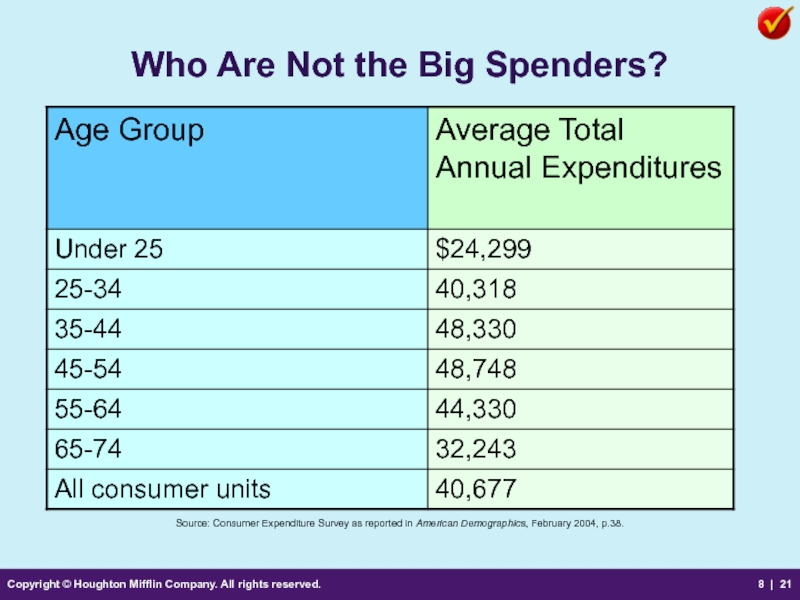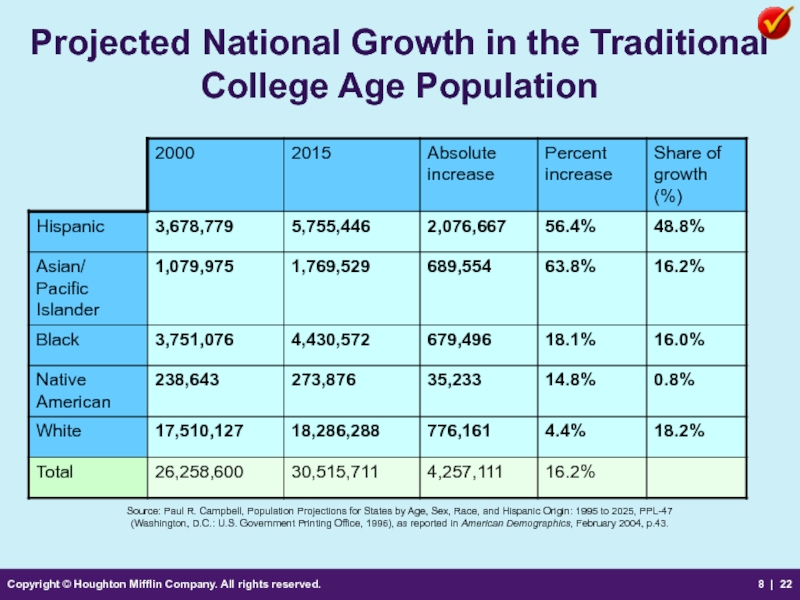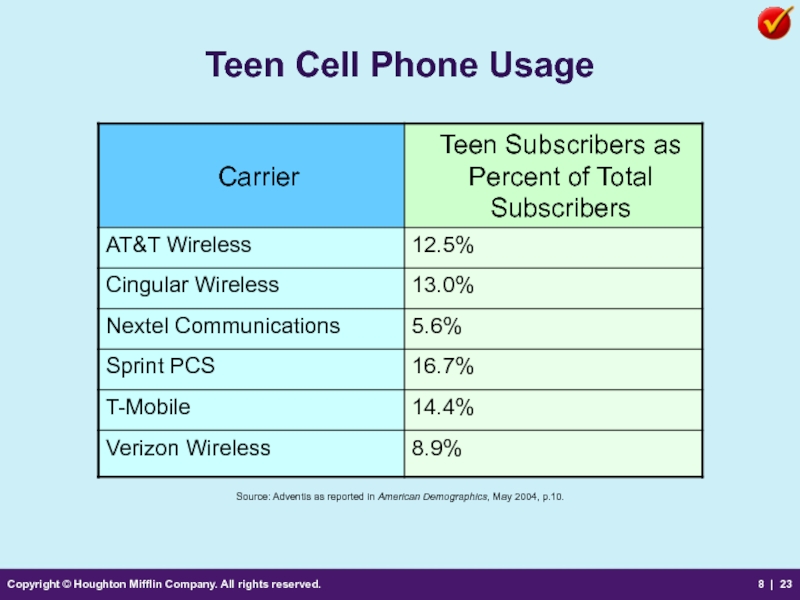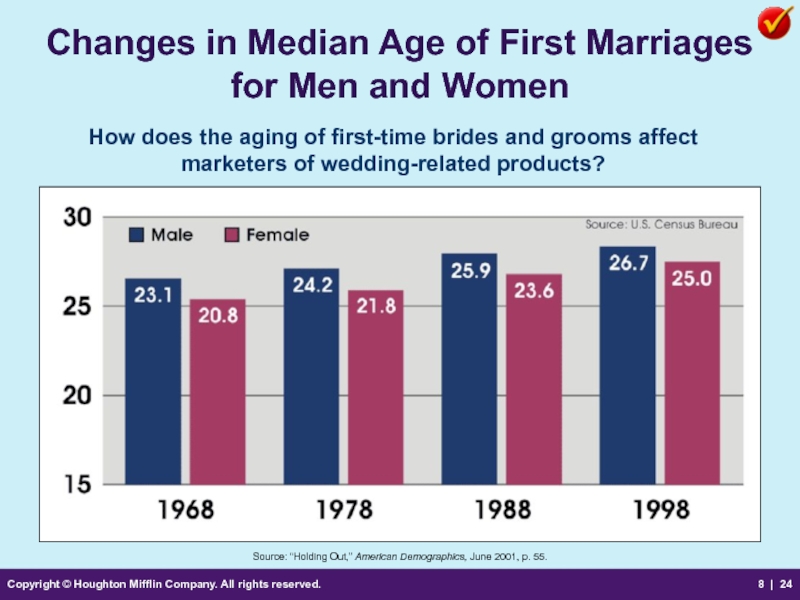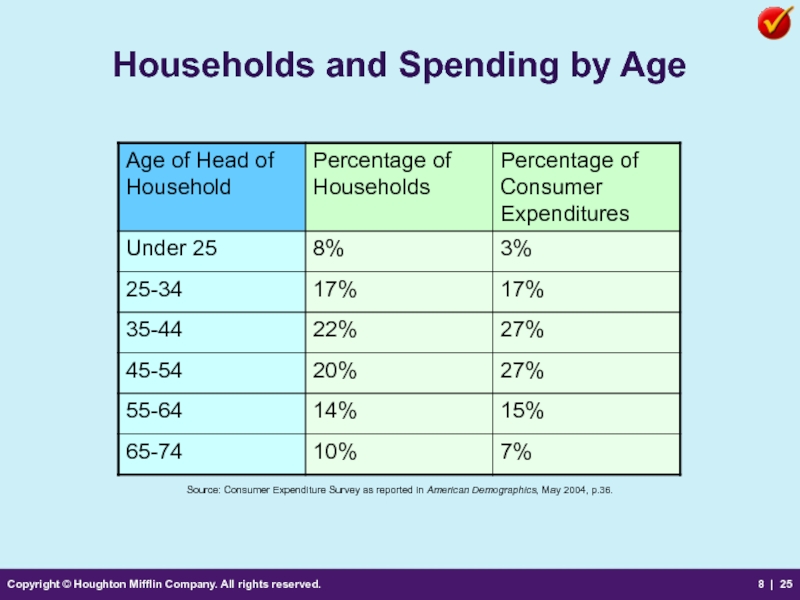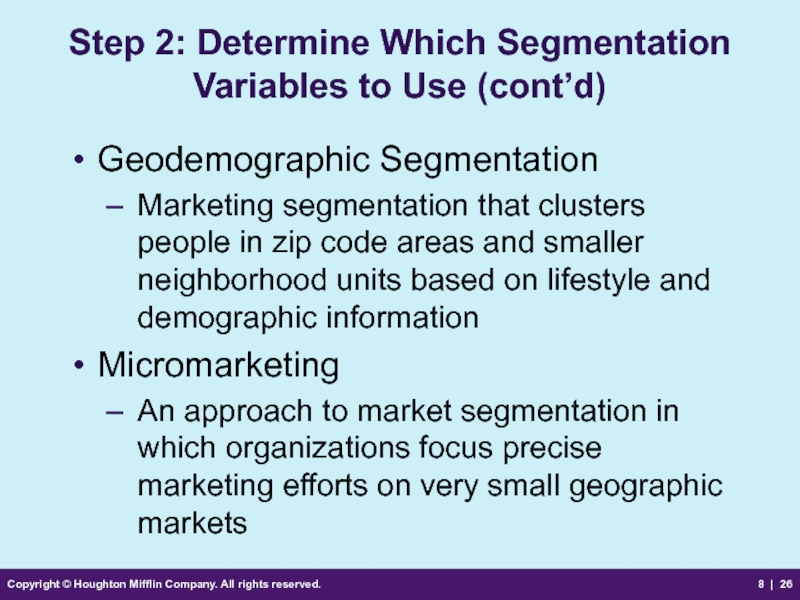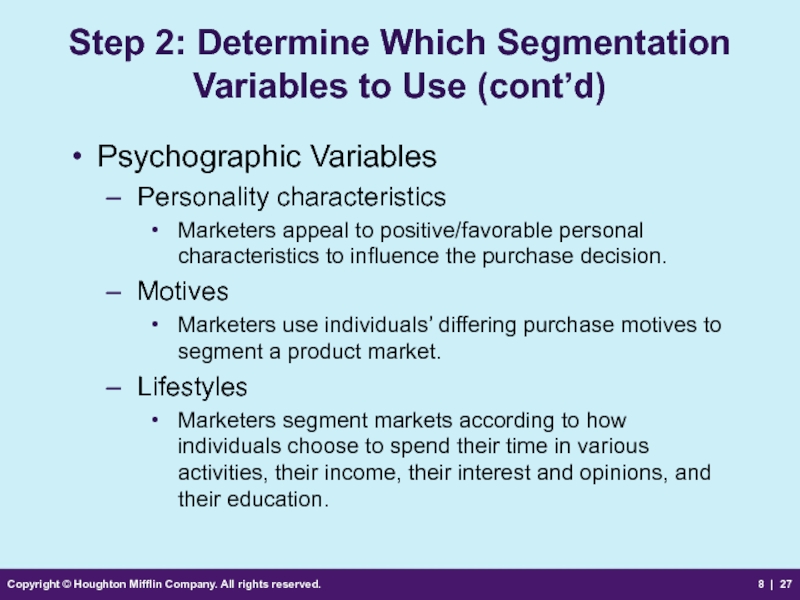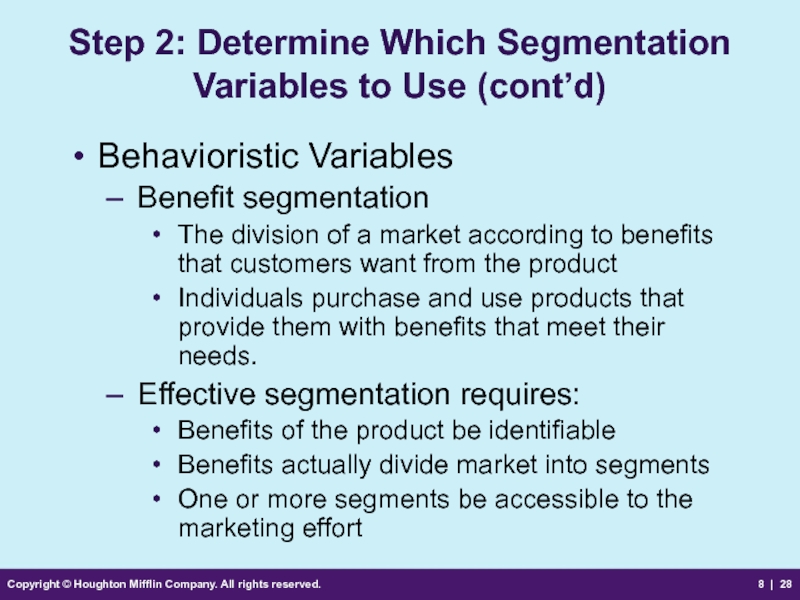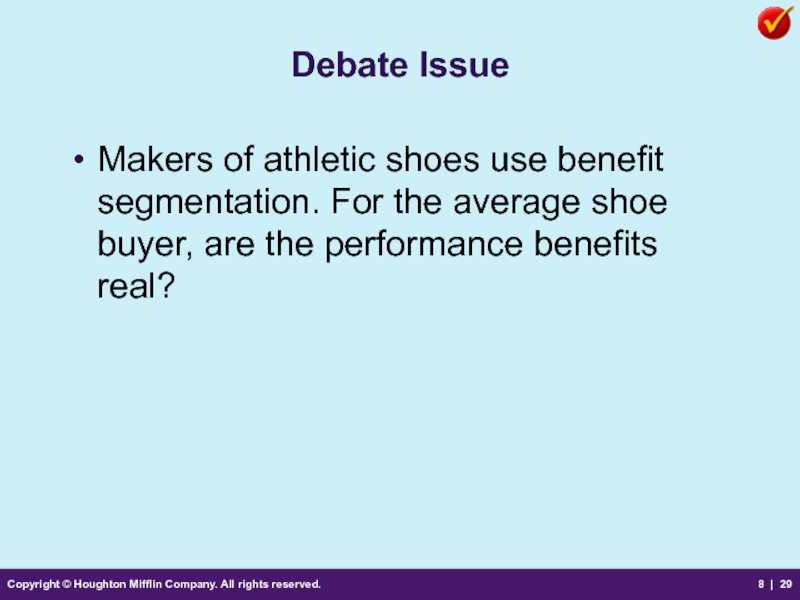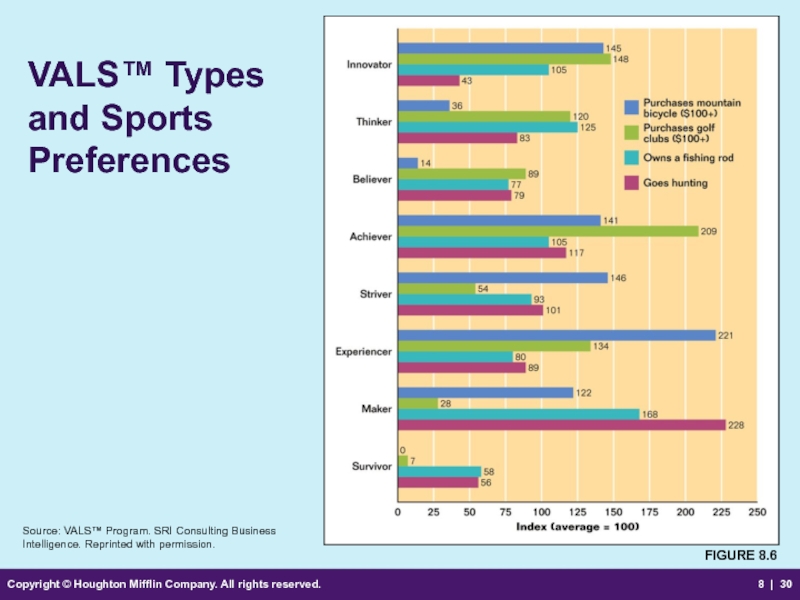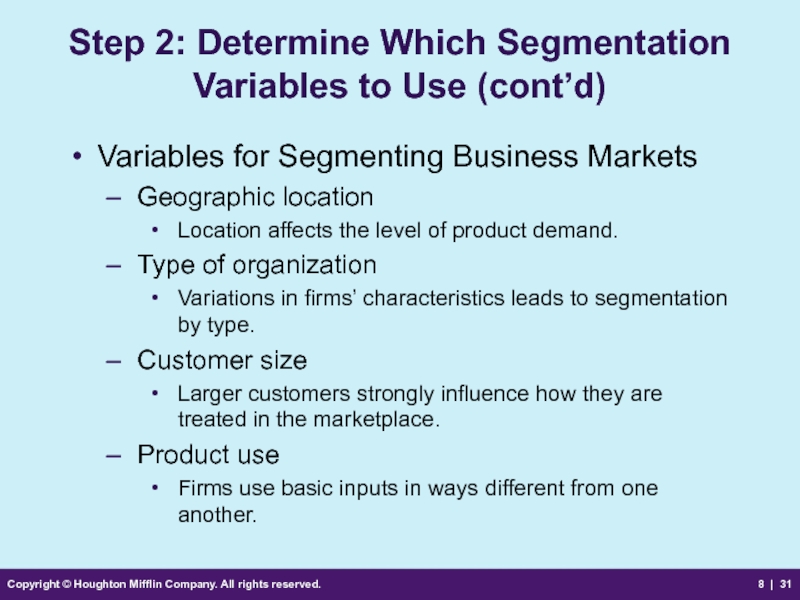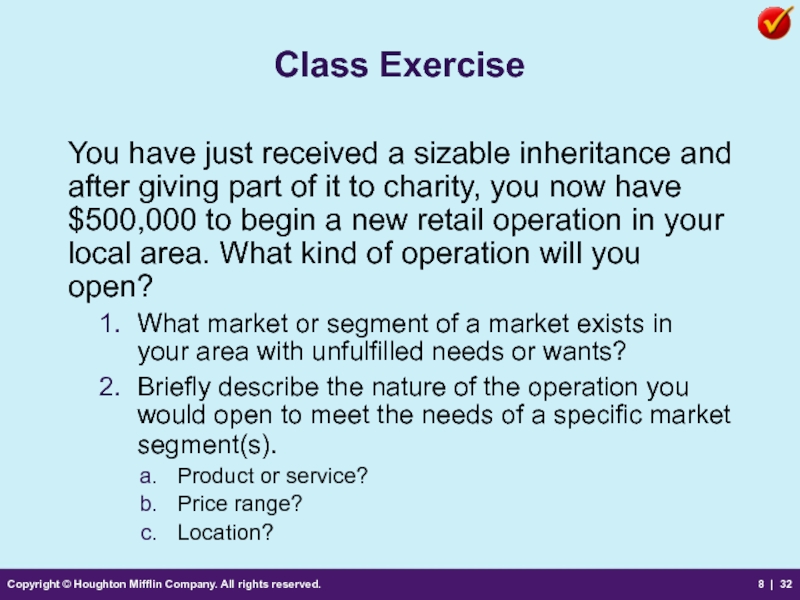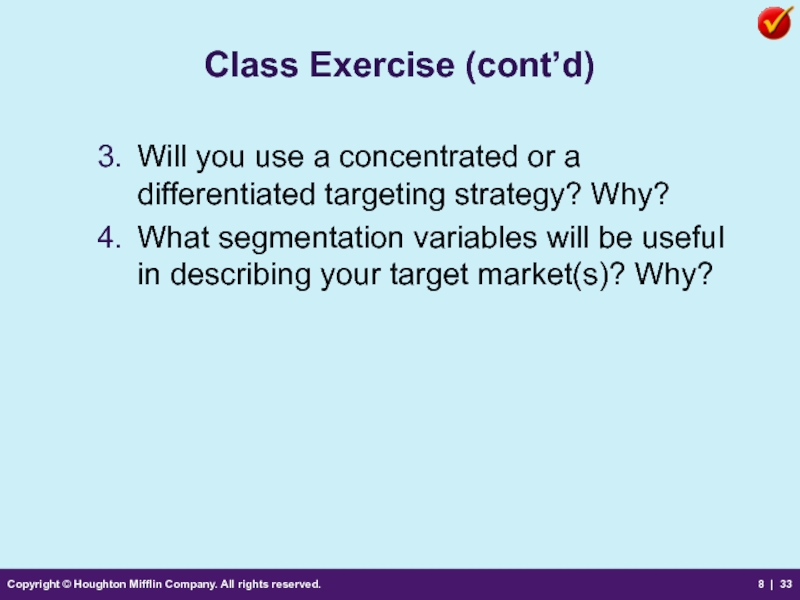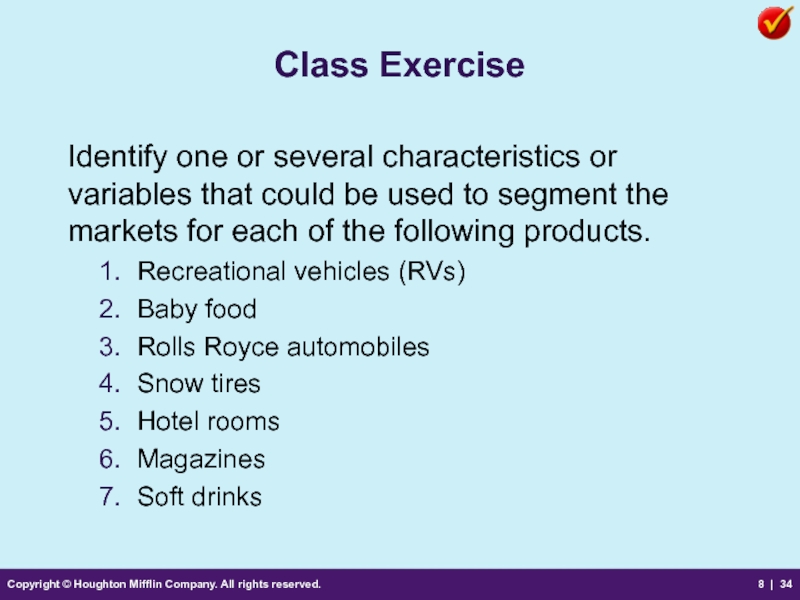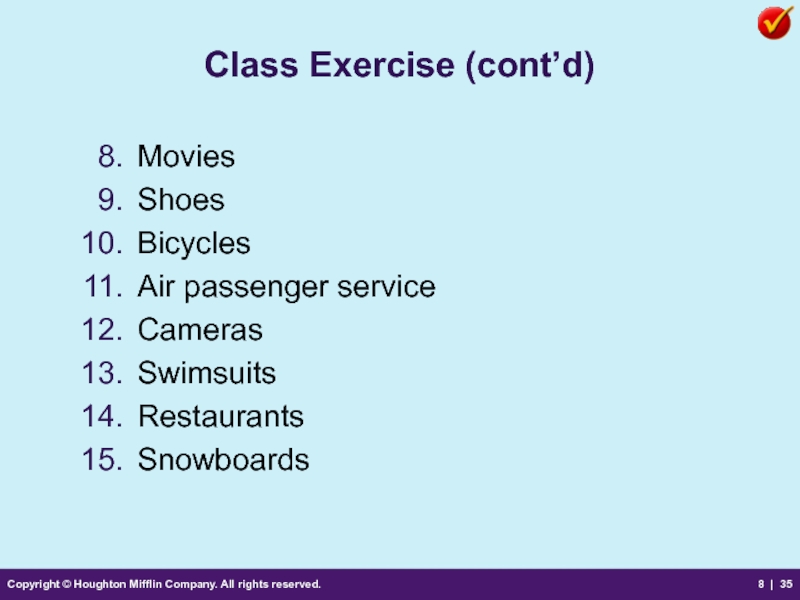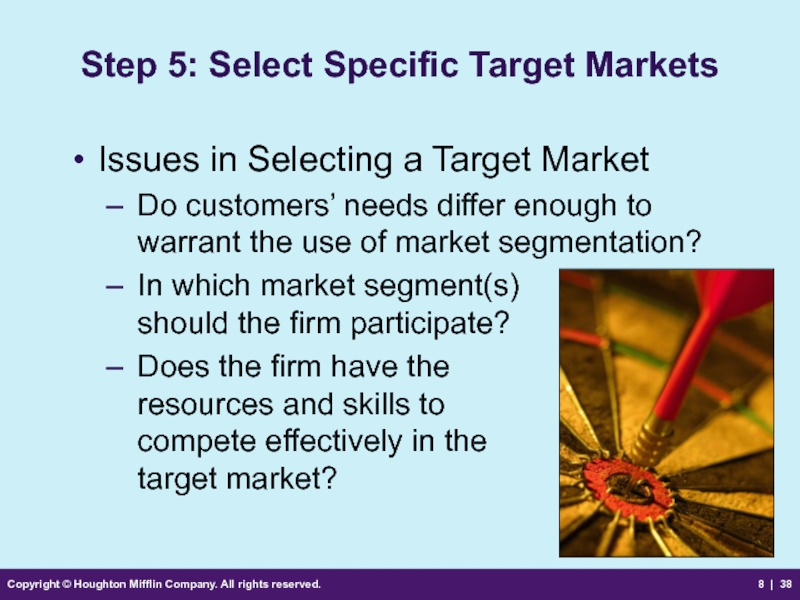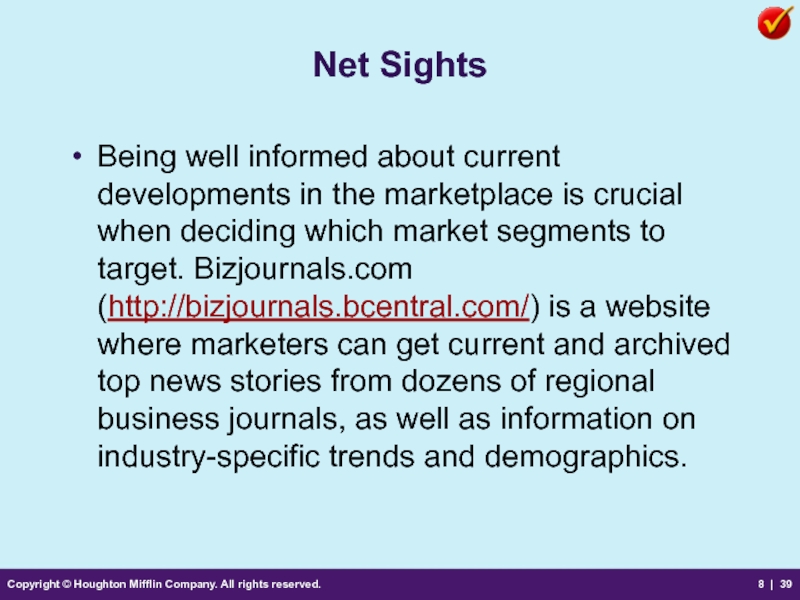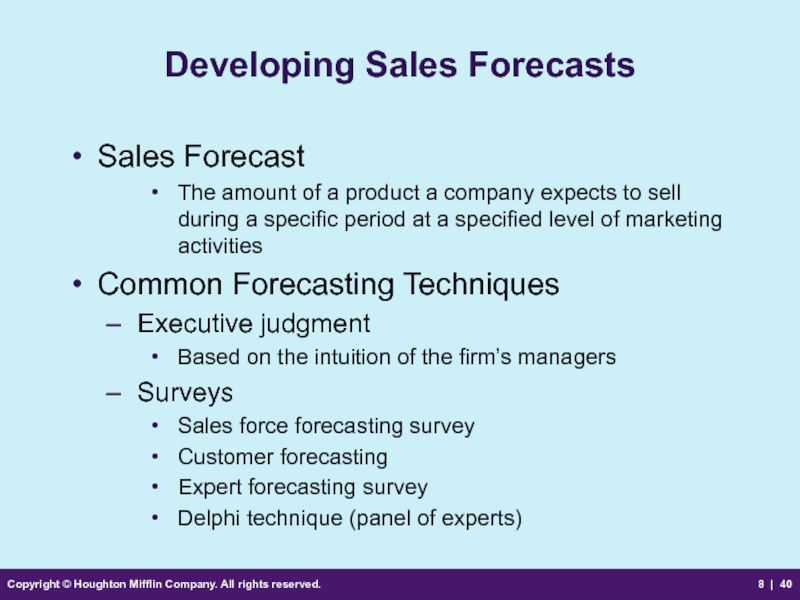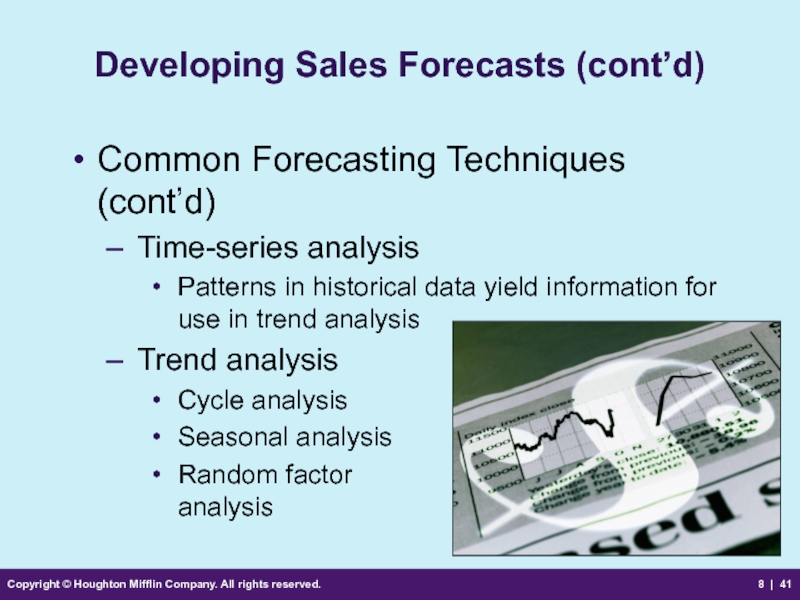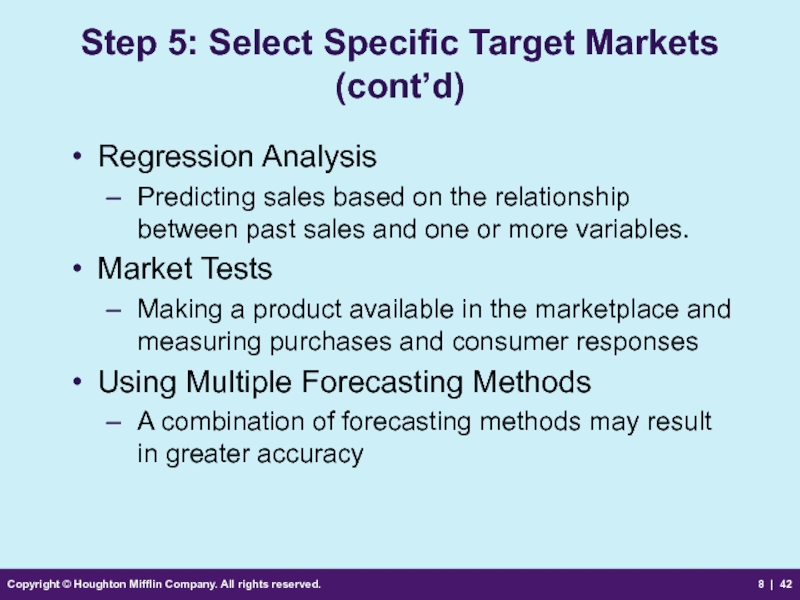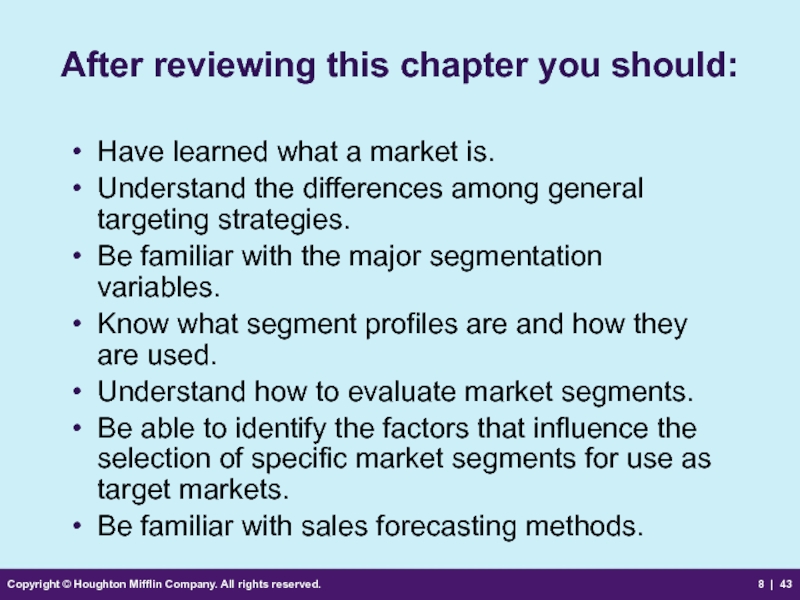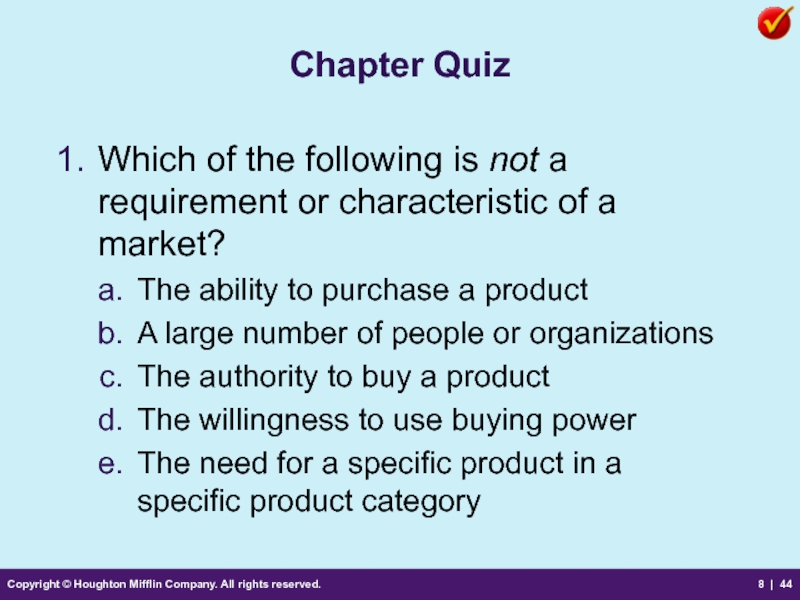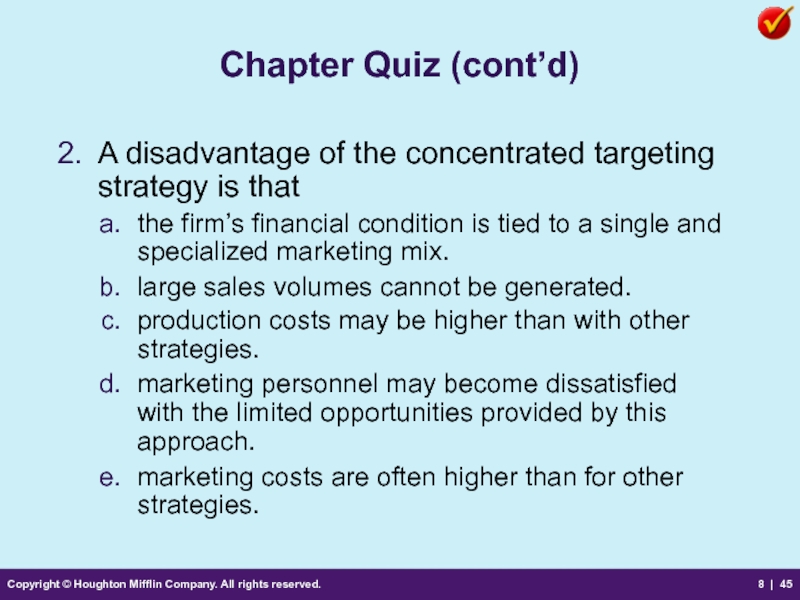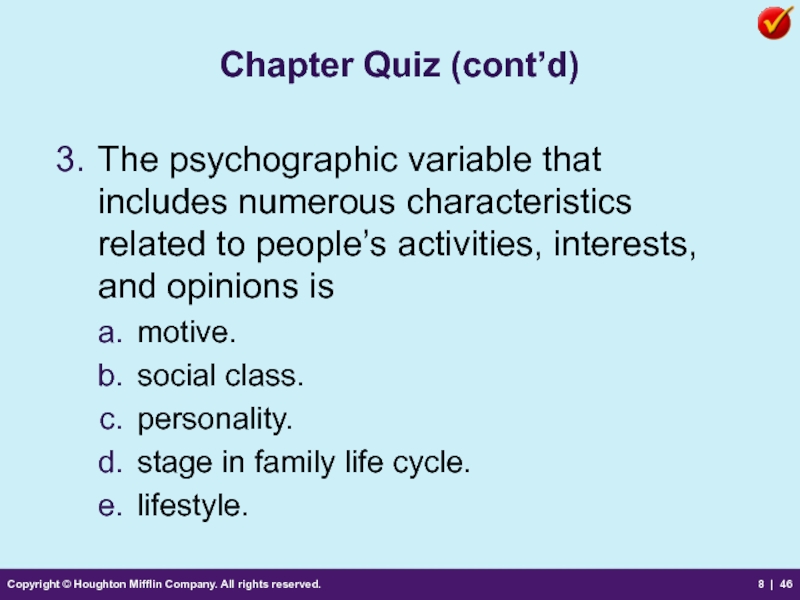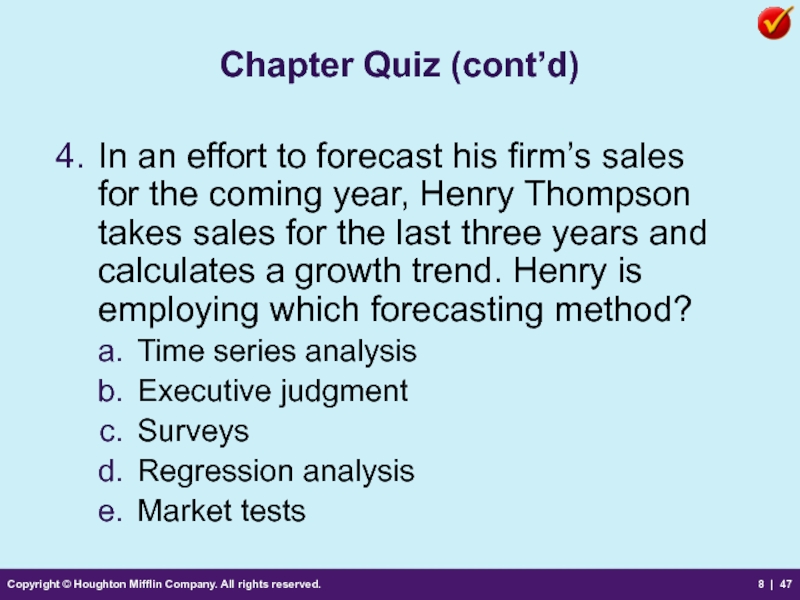- Главная
- Разное
- Дизайн
- Бизнес и предпринимательство
- Аналитика
- Образование
- Развлечения
- Красота и здоровье
- Финансы
- Государство
- Путешествия
- Спорт
- Недвижимость
- Армия
- Графика
- Культурология
- Еда и кулинария
- Лингвистика
- Английский язык
- Астрономия
- Алгебра
- Биология
- География
- Детские презентации
- Информатика
- История
- Литература
- Маркетинг
- Математика
- Медицина
- Менеджмент
- Музыка
- МХК
- Немецкий язык
- ОБЖ
- Обществознание
- Окружающий мир
- Педагогика
- Русский язык
- Технология
- Физика
- Философия
- Химия
- Шаблоны, картинки для презентаций
- Экология
- Экономика
- Юриспруденция
Part four target markets and customer behavior презентация
Содержание
- 1. Part four target markets and customer behavior
- 2. Copyright © Houghton Mifflin Company. All rights
- 3. Copyright © Houghton Mifflin Company. All rights
- 4. Copyright © Houghton Mifflin Company. All rights
- 5. Copyright © Houghton Mifflin Company. All rights
- 6. Copyright © Houghton Mifflin Company. All rights
- 7. Copyright © Houghton Mifflin Company. All rights
- 8. Copyright © Houghton Mifflin Company. All rights reserved. 8 | Targeting Strategies FIGURE 8.2
- 9. Copyright © Houghton Mifflin Company. All rights reserved. 8 | Targeting Strategies FIGURE 8.2
- 10. Copyright © Houghton Mifflin Company. All rights reserved. 8 | Targeting Strategies FIGURE 8.2
- 11. Copyright © Houghton Mifflin Company. All rights
- 12. Copyright © Houghton Mifflin Company. All rights
- 13. Copyright © Houghton Mifflin Company. All rights
- 14. Copyright © Houghton Mifflin Company. All rights
- 15. Copyright © Houghton Mifflin Company. All rights
- 16. Copyright © Houghton Mifflin Company. All rights
- 17. Copyright © Houghton Mifflin Company. All rights
- 18. Copyright © Houghton Mifflin Company. All rights reserved. 8 |
- 19. Copyright © Houghton Mifflin Company. All rights
- 20. Copyright © Houghton Mifflin Company. All rights
- 21. Copyright © Houghton Mifflin Company. All rights
- 22. Copyright © Houghton Mifflin Company. All rights
- 23. Copyright © Houghton Mifflin Company. All rights
- 24. Copyright © Houghton Mifflin Company. All rights
- 25. Copyright © Houghton Mifflin Company. All rights
- 26. Copyright © Houghton Mifflin Company. All rights
- 27. Copyright © Houghton Mifflin Company. All rights
- 28. Copyright © Houghton Mifflin Company. All rights
- 29. Copyright © Houghton Mifflin Company. All rights
- 30. Copyright © Houghton Mifflin Company. All rights
- 31. Copyright © Houghton Mifflin Company. All rights
- 32. Copyright © Houghton Mifflin Company. All rights
- 33. Copyright © Houghton Mifflin Company. All rights
- 34. Copyright © Houghton Mifflin Company. All rights
- 35. Copyright © Houghton Mifflin Company. All rights
- 36. Copyright © Houghton Mifflin Company. All rights
- 37. Copyright © Houghton Mifflin Company. All rights
- 38. Copyright © Houghton Mifflin Company. All rights
- 39. Copyright © Houghton Mifflin Company. All rights
- 40. Copyright © Houghton Mifflin Company. All rights
- 41. Copyright © Houghton Mifflin Company. All rights
- 42. Copyright © Houghton Mifflin Company. All rights
- 43. Copyright © Houghton Mifflin Company. All rights
- 44. Copyright © Houghton Mifflin Company. All rights
- 45. Copyright © Houghton Mifflin Company. All rights
- 46. Copyright © Houghton Mifflin Company. All rights
- 47. Copyright © Houghton Mifflin Company. All rights
Слайд 2Copyright © Houghton Mifflin Company. All rights reserved.
8 |
Objectives
To learn
To understand the differences among general targeting strategies
To become familiar with the major segmentation variables
To know what segment profiles are and how they are used
To understand how to evaluate market segments
Слайд 3Copyright © Houghton Mifflin Company. All rights reserved.
8 |
Objectives (cont’d)
To
To become familiar with sales forecasting methods
Слайд 4Copyright © Houghton Mifflin Company. All rights reserved.
8 |
Chapter Outline
What
Target Market Selection Process
Step 1: Identify the Appropriate Targeting Strategy
Step 2: Determine Which Segmentation Variables to Use
Step 3: Develop Market Segment Profiles
Step 4: Evaluate Relevant Market Segments
Step 5: Select Specific Target Markets
Developing Sales Forecasts
Слайд 5Copyright © Houghton Mifflin Company. All rights reserved.
8 |
What Are
Requirements of a Market
Must need or desire a particular product
Must have the ability to purchase the product
Must be willing to use their
buying power
Must have the authority to
buy specific products
Слайд 6Copyright © Houghton Mifflin Company. All rights reserved.
8 |
What Are
Types of Markets
Consumer markets
Purchasers and individuals in households
Purchases are for personal consumption, not profit
Business markets
Individuals and groups that purchase products for resale, direct use to produce other products, or use in daily business operations
Purchasers classed as producers, resellers, government, and institutional markets
Слайд 7Copyright © Houghton Mifflin Company. All rights reserved.
8 |
Target Market
FIGURE 8.1
Слайд 10Copyright © Houghton Mifflin Company. All rights reserved.
8 |
Targeting Strategies
FIGURE
Слайд 11Copyright © Houghton Mifflin Company. All rights reserved.
8 |
Step 1:
Undifferentiated Strategy
Defining an entire market for
a particular product as the
target market (homogeneous
market)
Designing a single marketing
mix for and directing it at the
total market
Слайд 12Copyright © Houghton Mifflin Company. All rights reserved.
8 |
Step 1:
Concentrated Strategy Through Market Segmentation
Segmenting (dividing) the total market into groups with similar product needs (heterogeneous markets) to
design marketing mixes that
match those needs
Concentrated targeting strategy
focuses on a single market
segment using one marketing
mix
Слайд 13Copyright © Houghton Mifflin Company. All rights reserved.
8 |
Step 1:
Differentiated Strategy Through Market Segmentation
Targeting two or more segments by developing a marketing mix for each
Competitive advantage is that a firm may gain a larger total market share by aiming multiple marketing mixes at multiple segments
Слайд 14Copyright © Houghton Mifflin Company. All rights reserved.
8 |
What Type
Reprinted with permission of KF Holdings, Inc.
Слайд 15Copyright © Houghton Mifflin Company. All rights reserved.
8 |
Step 2:
Segmentation Variables
Characteristics of individuals, groups, or organizations used to divide a market into segments
Слайд 16Copyright © Houghton Mifflin Company. All rights reserved.
8 |
Segmentation Variables
FIGURE 8.3
Слайд 17Copyright © Houghton Mifflin Company. All rights reserved.
8 |
Spending Levels
FIGURE 8.4
Source: U.S. Department of Labor, Bureau of Labor Statistics. August 2000.
Слайд 19Copyright © Houghton Mifflin Company. All rights reserved.
8 |
Family Life
FIGURE 8.5
Source: Bureau of the Census, Current Population Survey.
Слайд 20Copyright © Houghton Mifflin Company. All rights reserved.
8 |
Step 2:
Demographic Variables
Population characteristics such as age, gender, race, ethnicity, income, education
Geographic Variables
Customer product needs are influenced by climate, terrain, city size, population density, and urban/rural areas
Market Density
The number of potential customers within a unit of land area
Слайд 21Copyright © Houghton Mifflin Company. All rights reserved.
8 |
Who Are
Source: Consumer Expenditure Survey as reported in American Demographics, February 2004, p.38.
Слайд 22Copyright © Houghton Mifflin Company. All rights reserved.
8 |
Projected National
Source: Paul R. Campbell, Population Projections for States by Age, Sex, Race, and Hispanic Origin: 1995 to 2025, PPL-47
(Washington, D.C.: U.S. Government Printing Office, 1996), as reported in American Demographics, February 2004, p.43.
Слайд 23Copyright © Houghton Mifflin Company. All rights reserved.
8 |
Teen Cell
Source: Adventis as reported in American Demographics, May 2004, p.10.
Слайд 24Copyright © Houghton Mifflin Company. All rights reserved.
8 |
Changes in
How does the aging of first-time brides and grooms affect marketers of wedding-related products?
Source: “Holding Out,” American Demographics, June 2001, p. 55.
Young Adults take longer to settle down. Estimated age at first marriage by gender.
Слайд 25Copyright © Houghton Mifflin Company. All rights reserved.
8 |
Households and
Source: Consumer Expenditure Survey as reported in American Demographics, May 2004, p.36.
Слайд 26Copyright © Houghton Mifflin Company. All rights reserved.
8 |
Step 2:
Geodemographic Segmentation
Marketing segmentation that clusters people in zip code areas and smaller neighborhood units based on lifestyle and demographic information
Micromarketing
An approach to market segmentation in which organizations focus precise marketing efforts on very small geographic markets
Слайд 27Copyright © Houghton Mifflin Company. All rights reserved.
8 |
Step 2:
Psychographic Variables
Personality characteristics
Marketers appeal to positive/favorable personal characteristics to influence the purchase decision.
Motives
Marketers use individuals’ differing purchase motives to segment a product market.
Lifestyles
Marketers segment markets according to how individuals choose to spend their time in various activities, their income, their interest and opinions, and their education.
Слайд 28Copyright © Houghton Mifflin Company. All rights reserved.
8 |
Step 2:
Behavioristic Variables
Benefit segmentation
The division of a market according to benefits that customers want from the product
Individuals purchase and use products that provide them with benefits that meet their needs.
Effective segmentation requires:
Benefits of the product be identifiable
Benefits actually divide market into segments
One or more segments be accessible to the marketing effort
Слайд 29Copyright © Houghton Mifflin Company. All rights reserved.
8 |
Debate Issue
Makers
Слайд 30Copyright © Houghton Mifflin Company. All rights reserved.
8 |
VALS™ Types
FIGURE 8.6
Source: VALS™ Program. SRI Consulting Business Intelligence. Reprinted with permission.
Слайд 31Copyright © Houghton Mifflin Company. All rights reserved.
8 |
Step 2:
Variables for Segmenting Business Markets
Geographic location
Location affects the level of product demand.
Type of organization
Variations in firms’ characteristics leads to segmentation by type.
Customer size
Larger customers strongly influence how they are treated in the marketplace.
Product use
Firms use basic inputs in ways different from one another.
Слайд 32Copyright © Houghton Mifflin Company. All rights reserved.
8 |
Class Exercise
You
What market or segment of a market exists in your area with unfulfilled needs or wants?
Briefly describe the nature of the operation you would open to meet the needs of a specific market segment(s).
Product or service?
Price range?
Location?
Слайд 33Copyright © Houghton Mifflin Company. All rights reserved.
8 |
Class Exercise
Will you use a concentrated or a differentiated targeting strategy? Why?
What segmentation variables will be useful in describing your target market(s)? Why?
Слайд 34Copyright © Houghton Mifflin Company. All rights reserved.
8 |
Class Exercise
Identify
Recreational vehicles (RVs)
Baby food
Rolls Royce automobiles
Snow tires
Hotel rooms
Magazines
Soft drinks
Слайд 35Copyright © Houghton Mifflin Company. All rights reserved.
8 |
Class Exercise
Movies
Shoes
Bicycles
Air passenger service
Cameras
Swimsuits
Restaurants
Snowboards
Слайд 36Copyright © Houghton Mifflin Company. All rights reserved.
8 |
Step 3:
Market Segment Profile
Describes the similarities among potential customers within a segment
Covers demographic characteristics, geographic factors,
benefits sought,
lifestyles, brand
preferences, and
usage rates
Слайд 37Copyright © Houghton Mifflin Company. All rights reserved.
8 |
Step 4:
Sales Estimates
Market potential
Company sales potential
Measuring Sales Potential
Breakdown approach: top-down analysis
Build-up approach: bottom-up analysis
Competitive Assessment
Who, how many, how large, and how strong?
Cost Estimates
The expense of developing a marketing mix
Costs of reaching segment relative to competitors’ costs
Слайд 38Copyright © Houghton Mifflin Company. All rights reserved.
8 |
Step 5:
Issues in Selecting a Target Market
Do customers’ needs differ enough to
warrant the use of market segmentation?
In which market segment(s)
should the firm participate?
Does the firm have the
resources and skills to
compete effectively in the
target market?
Слайд 39Copyright © Houghton Mifflin Company. All rights reserved.
8 |
Net Sights
Being
Слайд 40Copyright © Houghton Mifflin Company. All rights reserved.
8 |
Developing Sales
Sales Forecast
The amount of a product a company expects to sell during a specific period at a specified level of marketing activities
Common Forecasting Techniques
Executive judgment
Based on the intuition of the firm’s managers
Surveys
Sales force forecasting survey
Customer forecasting
Expert forecasting survey
Delphi technique (panel of experts)
Слайд 41Copyright © Houghton Mifflin Company. All rights reserved.
8 |
Developing Sales
Common Forecasting Techniques (cont’d)
Time-series analysis
Patterns in historical data yield information for use in trend analysis
Trend analysis
Cycle analysis
Seasonal analysis
Random factor
analysis
Слайд 42Copyright © Houghton Mifflin Company. All rights reserved.
8 |
Step 5:
Regression Analysis
Predicting sales based on the relationship between past sales and one or more variables.
Market Tests
Making a product available in the marketplace and measuring purchases and consumer responses
Using Multiple Forecasting Methods
A combination of forecasting methods may result in greater accuracy
Слайд 43Copyright © Houghton Mifflin Company. All rights reserved.
8 |
After reviewing
Have learned what a market is.
Understand the differences among general targeting strategies.
Be familiar with the major segmentation variables.
Know what segment profiles are and how they are used.
Understand how to evaluate market segments.
Be able to identify the factors that influence the selection of specific market segments for use as target markets.
Be familiar with sales forecasting methods.
Слайд 44Copyright © Houghton Mifflin Company. All rights reserved.
8 |
Chapter Quiz
Which
The ability to purchase a product
A large number of people or organizations
The authority to buy a product
The willingness to use buying power
The need for a specific product in a specific product category
Слайд 45Copyright © Houghton Mifflin Company. All rights reserved.
8 |
Chapter Quiz
A disadvantage of the concentrated targeting strategy is that
the firm’s financial condition is tied to a single and specialized marketing mix.
large sales volumes cannot be generated.
production costs may be higher than with other strategies.
marketing personnel may become dissatisfied with the limited opportunities provided by this approach.
marketing costs are often higher than for other strategies.
Слайд 46Copyright © Houghton Mifflin Company. All rights reserved.
8 |
Chapter Quiz
The psychographic variable that includes numerous characteristics related to people’s activities, interests, and opinions is
motive.
social class.
personality.
stage in family life cycle.
lifestyle.
Слайд 47Copyright © Houghton Mifflin Company. All rights reserved.
8 |
Chapter Quiz
In an effort to forecast his firm’s sales for the coming year, Henry Thompson takes sales for the last three years and calculates a growth trend. Henry is employing which forecasting method?
Time series analysis
Executive judgment
Surveys
Regression analysis
Market tests

